1. Introduction
 After having tested the Asus EAX1650XT, we were given the opportunity to trial the Crossfire edition, and perform additional tests in order to see if we can expect better performance using Crossfire technology.
After having tested the Asus EAX1650XT, we were given the opportunity to trial the Crossfire edition, and perform additional tests in order to see if we can expect better performance using Crossfire technology.
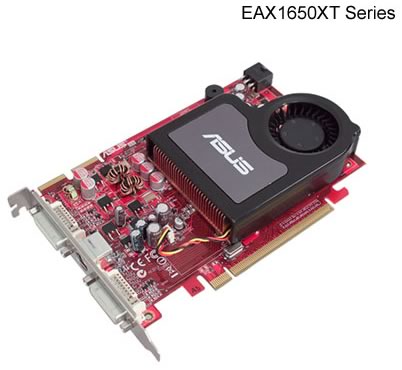
Both the normal and Crossfire models look exactly the same. The only differences are the two internal Crossfire connectors.

In order to use CrossFire, there are several system requirements
- A standard ASUS EAX1650XT graphics card
- An additional ASUS EAX1650XT CrossFire™ edition graphics card (with two pieces of CrossFire bridge interconnectors inside the box)
- A CrossFire™ Ready motherboard
- 512MB of system memory
- 550 watt power supply or greater, 38 Amps, 12 volt rail
Below you can see how the two cards are connected.

For our tests we used an Asus P5W64WS Pro motherboard with Intel Core2Duo Processor (E6600) and 2GB of memory. Our "standard" PC setup is somewhat different this time, but our tests have shown that CPU has little impact on absolute RAW performance figures. We used the latest ATI Catalyst v7.2 driver pack for all tests

with the following settings

More information about the card can be obtained within ATI Catalyst:

and Everest Ultimate Edition

Enabling Crossfire from ATI Catalyst is very simple:


We used numerous games and applications to evaluate the VGA card's performance:
- FRAPS v2.8.0
- 3D Mark 05 v1.2.0
- 3D Mark 06 v1.0.2
- F.E.A.R v1.08
- Prey v1.2.0
- Half Life 2 Episode 1 June Edition
- Splinter Cell - Chaos Theory v1.05
- Battlefield 2142 v1.00
- Company Of Heroes v1.3.0
- Neverwinter Nights 2 v1.04
- NFS Carbon v1.2.0
For comparison, we will provide results for the following VGA cards:
- Foxconn 7900GS
- 7900GS SLI
All Nvidia based cards results were obtained with Nvidia Forceware v93.71drivers.
2. 3D Mark 05 - 3D Mark 06
 3DMark®05 is best suited for the latest generation of DirectX®9.0 graphics cards. It is the first benchmark to require a DirectX9.0 compliant hardware with support for Pixel Shaders 2.0 or higher! By combining high quality 3D tests, CPU tests, feature tests, image quality tools, and much more, 3DMark05 is a premium benchmark for evaluating the latest generation of gaming hardware. 3DMark05 is the answer to the continuously growing challenge in benchmarking!
3DMark®05 is best suited for the latest generation of DirectX®9.0 graphics cards. It is the first benchmark to require a DirectX9.0 compliant hardware with support for Pixel Shaders 2.0 or higher! By combining high quality 3D tests, CPU tests, feature tests, image quality tools, and much more, 3DMark05 is a premium benchmark for evaluating the latest generation of gaming hardware. 3DMark05 is the answer to the continuously growing challenge in benchmarking!
For all tests, we used the default settings as follows:
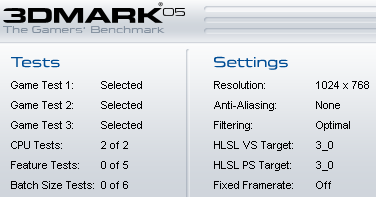
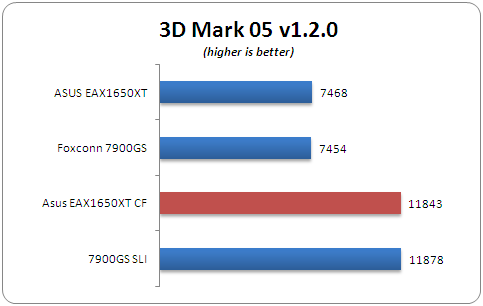
3D Mark 05 is a well know benchmark utility that represents the combination of CPU+VGA strength. The Asus EAX1650XT CF was slightly behind the 7900GS SLI setup.
- 3D Mark 06 v1.0.2
 3DMark®06 is the worldwide standard in advanced 3D game performance benchmarking and the latest version in the popular 3DMark series! 3DMark06 tests include all new HDR/SM3.0 graphics tests, advanced SM2.0 graphics tests, AI and physics driven single and multiple cores or processor CPU tests and a collection of comprehensive feature tests to reliably measure next generation gaming performance today. Futuremark's exclusive Online ResultBrowser web service tracks and compares 3DMark06 scores. Again we left all settings as default:
3DMark®06 is the worldwide standard in advanced 3D game performance benchmarking and the latest version in the popular 3DMark series! 3DMark06 tests include all new HDR/SM3.0 graphics tests, advanced SM2.0 graphics tests, AI and physics driven single and multiple cores or processor CPU tests and a collection of comprehensive feature tests to reliably measure next generation gaming performance today. Futuremark's exclusive Online ResultBrowser web service tracks and compares 3DMark06 scores. Again we left all settings as default:

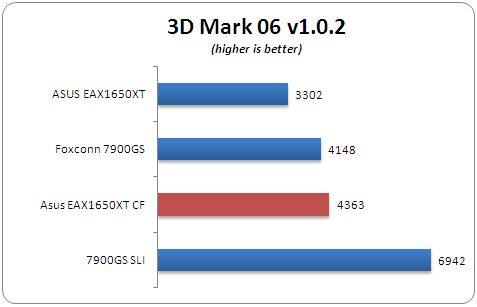
In 3D Mark 06, the performance of the Asus EAX1650XT CF was a good deal lower than a 7900GS SLI setup. This should be an indication of real gaming performance...
3. F.E.A.R.
 The story begins as an unidentified paramilitary force infiltrates a multi-billion dollar aerospace compound. The government responds by sending in Special Forces, but loses contact as an eerie signal interrupts radio communications. When the interference subsides moments later, the team has been literally torn apart. As part of a classified strike team created to deal with threats no one else can handle, your mission is simple: Eliminate the intruders at any cost. Determine the origin of the signal. And contain this crisis before it spirals out of control.
The story begins as an unidentified paramilitary force infiltrates a multi-billion dollar aerospace compound. The government responds by sending in Special Forces, but loses contact as an eerie signal interrupts radio communications. When the interference subsides moments later, the team has been literally torn apart. As part of a classified strike team created to deal with threats no one else can handle, your mission is simple: Eliminate the intruders at any cost. Determine the origin of the signal. And contain this crisis before it spirals out of control.
For all tests, we used the latest available patch which updates the game engine to v1.08. The game offers 1280x1024 resolution, which was used for all tests. We maxed all details for CPU and VGA card, except for Soft Shadows and AA/AF. We used the card's 3D Control panel to enable AA/AF as shown in each graph.
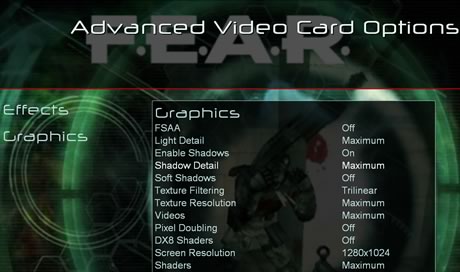
Below are the results after using the built-in benchmark test:

The Asus EAX1650XT CF produced 67 FPS average performance without AA/AF rendering modes enabled. The 7900GS SLI had 100FPS for the same test.

Enabling AA/AF produces a performance hit on all tested cards. Looking at the performance of the Asus EAX1650XT CF and 7900GS SLI, in all cases, Nvidia based cards offer much better performance.
4. Prey
 Prey tells the story of Tommy, a Cherokee garage mechanic stuck on a reservation going nowhere. His life changes when an otherworldly crisis forces him to awaken spiritual powers from his long-forgotten birthright. Abducted along with his people to a menacing mothership orbiting Earth, he sets out to save himself and his girlfriend and eventually his planet.
Prey tells the story of Tommy, a Cherokee garage mechanic stuck on a reservation going nowhere. His life changes when an otherworldly crisis forces him to awaken spiritual powers from his long-forgotten birthright. Abducted along with his people to a menacing mothership orbiting Earth, he sets out to save himself and his girlfriend and eventually his planet.
Prey is serious, dark story, based on authentic Cherokee mythology. Themes of sacrifice, love and responsibility are explored and the story dives into emotional territory not yet explored by similar games. Prey is based on Quake 3 engine and for sure will keep you awake many nights...
We used the latest available patch to update the game engine to v1.2.0. For all tests we used hocbench which offers all benchmarking options through a GUI. We used the built-in Guru3D timedemo and all results are posted below:

Without enabling AA/AF, the Asus EAX1650XT CF reached 82 FPS.

Enabling the various AA/AF rendering modes, we saw that the Asus EAX1650XT CF is slower than the 7900GS SLI except for AF/16xQAA.
5. Splinter Cell Chaos Theory
 A Japanese Information Defense Force is formed to help face modern threats. Deemed a violation of international law and of the Japanese Post-War Constitution, Korea and China become outraged.
A Japanese Information Defense Force is formed to help face modern threats. Deemed a violation of international law and of the Japanese Post-War Constitution, Korea and China become outraged.
Secretly, the head of the IDF begins launching information-warfare attacks against Japan and blaming the attacks on North Korea. When the U.S. intervenes, as they are obligated to under Article 9 of the Japanese Post-War Constitution, the U.S. is attacked as well, forcing North Korea to escalate the situation with a pre-emptive invasion of South Korea. As war erupts on the Korean Peninsula, Sam Fisher must thwart the alliance between the Japanese Admiral, a neurotic computer hacker, and the head of an international paramilitary company in order to prevent the rekindling of a massive world war in the Pacific.
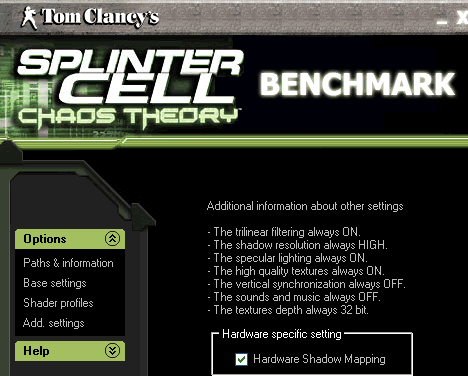
The graphics engine supports Pixel Shader 1 and 3, HDR along with other new effects. We used hocbench which offers all benchmarking options through an easy GUI. We used the built-in "Guru3D 2" timedemo and all results are posted below, using SM1.1
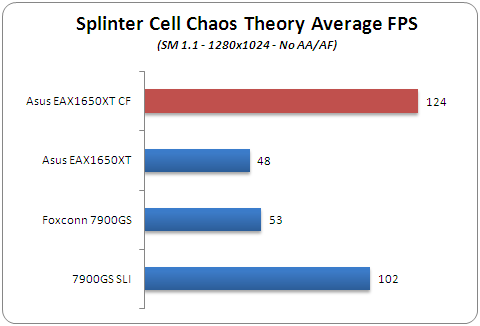
The Asus EAX1650XT CF was faster than the 7900GS SLI in this test (SM 1.1). Splinter Cell - Chaos Theory also supports Shader Model 3.0 which can be enabled from within the hocbench software:


SM3.0 offers much better visual details but at the cost of performance. In this mode, the Asus EAX1650XT CF produced the same framerate as the Foxconn 7900GS, which was almost half that of the 7900GS SLI. Splinter Cell Chaos Theory doesn't offer AA/AF modes, so we had to enable them from each VGA cards 3D Control panel.

Enabling AA/AF drops performance for all cards. The Nvidia 7900GS SLI setup is much faster than ATI's EAX1650XT CF.
6. Half Life 2 Episode 1
The world of Half-Life 2 has amazed everyone with its great story, graphics and Valve's great support. Half-Life 2: Episode One is the first in a series of new adventures created by Valve that extend the Half-Life 2 single player experience. It details the aftermath of Half Life 2 and launches a journey beyond City 17.
 Stepping into the hazard suit of Dr. Gordon Freeman, you face the immediate repercussions of your actions in City 17 and the Citadel. Rejoin Alyx Vance and her robot, Dog, to once again aid the human resistance in their desperate battle against the totalitarian alien menace of the Combine.
Stepping into the hazard suit of Dr. Gordon Freeman, you face the immediate repercussions of your actions in City 17 and the Citadel. Rejoin Alyx Vance and her robot, Dog, to once again aid the human resistance in their desperate battle against the totalitarian alien menace of the Combine.
Episode One exposes Alyx's combat skills and knowledge of City 17. Battle side-by-side with her through Valve's first episodic game, a four-to-six hour adventure of greater density and detail than non-episodic releases.
We recorded a timedemo and used the console to run it with each card. All tests were done at 1280x1024 with HDR shadows fully enabled. Antialiasing and Filtering modes were enabled through the 3D control panel:

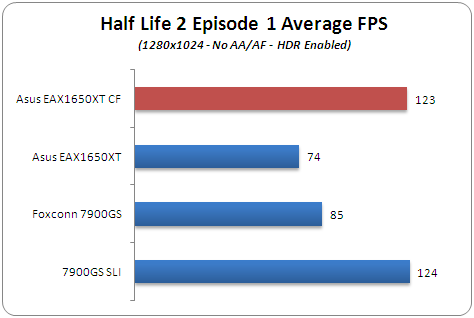
The HL2 Engine always has been a favorite one for ATI based cards. The Asus EAX1650XT CF is one FPS slower than the 7900GS SLI without the AA/AF rendering modes enabled.

HDR Effects and AA/AF do have an effect on performance. The Asus EAX1650XT was only slightly slower than the 7900GS SLI.
7. Company Of Heroes
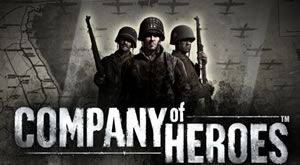 In Company of Heroes, gamers will experience the journey of the brave men of Able Company in a deep single-player campaign that begins with the invasion of Normandy through their fight across Europe, all set against the most dynamic battlefield ever seen in a game.
In Company of Heroes, gamers will experience the journey of the brave men of Able Company in a deep single-player campaign that begins with the invasion of Normandy through their fight across Europe, all set against the most dynamic battlefield ever seen in a game.
Company of Heroes' completely destructible environment means no two battles ever play out in the same way. Advanced squad AI delivers startling new realism and responsiveness, bringing soldiers to life as they interact with the environment and execute advanced squad tactics to eliminate the opposition forces.
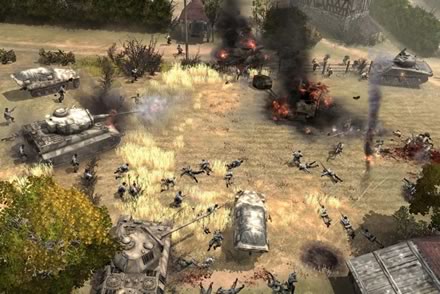
The game offers impressive graphics, especially when all visual quality settings are set at maximum.


We used the built-in benchmark for all tests at 1280x1024 resolution. Since AA/AF cannot be set from the game, we used Nvidia's 3D control panel for each mode. The built-in Antialiasing setting from within Company Of Heroes has been disabled. Let's see how each card performed in the Company Of Heroes Benchmark with High Quality settings.

The Asus EAX1650XT CF was slower by one FPS than the Foxconn 7900GS...

The Asus EAX1650XT CF has only a small drop in performance after enabling AA/AF modes. Strangely enough, it performed worse than a single EAX1650XT card, perhaps the drivers needs more work...
8. BattleField 2142
 The year is 2142, and the dawn of a new Ice age has thrown the world into a panic. The math is simple and brutal: The soil not covered by ice can only feed a fraction of the Earth's population. Some will live, most will die. In Battlefield 2142, players will choose to fight for one of two military superpowers in an epic battle for survival, the European Union or the newly formed Pan Asian Coalition.
The year is 2142, and the dawn of a new Ice age has thrown the world into a panic. The math is simple and brutal: The soil not covered by ice can only feed a fraction of the Earth's population. Some will live, most will die. In Battlefield 2142, players will choose to fight for one of two military superpowers in an epic battle for survival, the European Union or the newly formed Pan Asian Coalition.
Armed with a devastating arsenal of hi-tech assault rifles, cloaking devices and sentry guns, players will also do battle using some of the most imposing vehicles known to man. Massive battle Mechs wage fierce combat on the ground, while futuristic aircraft rule the skies. When facing one of these new behemoths, players will need to use their wits and an arsenal of new countermeasures like EMP grenades to level the playing field.

Team play features allow up to 64 players to enter the action on the front lines as part of a formal squad, or work behind the scenes in Commander Mode to direct the strategic assaults of their teammates. With in-game success, players increase their rank and unlock awards, including new weapons, medals and more, delivering the most comprehensive and flexible persistence in the Battlefield universe to date.

In order to benchmark the graphics cards, we recorded our own timedemo using the built-in command (demo.recordDemo). We then used the Guru3D BF2 benchmark, modified in order to support BF 2142 with the following quality settings Anti-aliasing is disabled from inside game, so we use the 3D Control Panel to enable/disable AA/AF rendering modes:
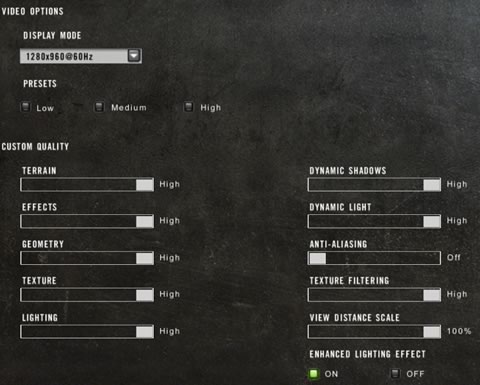
Note that 1280x1024 resolution is not supported in the game. However, it can be enabled from the command line. All tests performed at that resolution (1280x1024). Since the game counts all frames, including loading screens, we removed these so that all figures represent pure gaming experience. Note that all test were performed at 1280x1024 with the default camera view. Let's now proceed to the first test results.

At 1280x1024, the Asus EAX1650XT CF was very fast with 105 FPS performance.

Enabling AA/AF in Battlefield 2142, enhances visual quality and of course gaming experience. The Asus EAX1650XT CF was slower than the 7900GS SLI in most rendering modes as the above graph shows.
9. NFS Carbon
 Need for Speed Carbon delivers the next generation of adrenaline-filled street racing and will challenge players to face the ultimate test of driving skill on treacherous canyon roads.
Need for Speed Carbon delivers the next generation of adrenaline-filled street racing and will challenge players to face the ultimate test of driving skill on treacherous canyon roads.
What starts in the city is settled in the canyons as Need for Speed Carbon immerses you into the world's most dangerous and adrenaline-filled form of street racing. You and your crew must race in an all-out war for the city, risking everything to take over your rivals' neighbourhoods one block at a time. As the police turn up the heat, the battle ultimately shifts to Carbon Canyon, where territories and reputations can be lost on every perilous curve.

Lets race...
Need for Speed Carbon delivers the next generation of customization giving you the power to design and tweak your crew's cars in every way using the ground-breaking new Autosculpt technology. Represent your car class, your crew, and your turf in Need for Speed Carbon, the next revolution in racing games.
In order to benchmark the graphics cards, we drove two identical rounds on the same track with the same car. By using FRAPS, we recorded all 2 minutes of driving.

Black and beautiful...
Keep in mind that all tests results were done with "Blur Effect" and "Rain" disabled, since enabling them gives a huge performance hit on all cards. All other detail settings are maxed out. As usual, AA/AF modes are set through each card's 3D control panel. Without enabling AA/AF, we can see the performance of each card at 1280x1024.
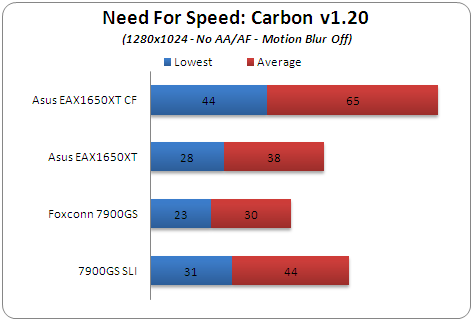
NFS Carbon is a no-go for Nvidia based cards. All ATI based cards however, showed superb performance and the Asus EAX1650XT CF reached 65 FPS average performance.
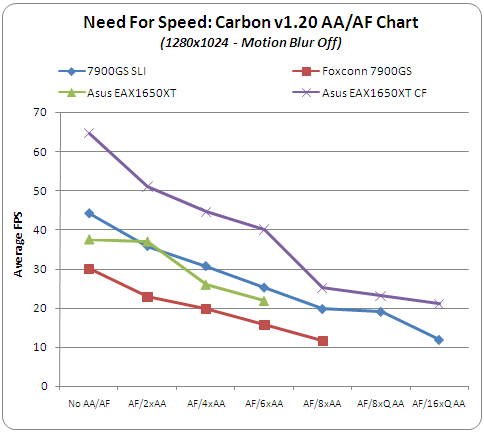
The game doesn't include any setting for AA/AF modes but they can be enabled from the control panel for each VGA card. The Asus EAX1650XT CF performed well, better than the 7900GS SLI.
10. NeverWinter Nights 2
 Bards sing tales of heroes from ages past, but never have the Forgotten Realms so desperately needed a champion. Years have passed since the war between Luskan and Neverwinter, almost enough time for the wounds of war to heal. But the brief peace the Realms have known may be at an end. Tension growing between the mighty city-states means the Sword Coast again teeters on the edge of open war.
Bards sing tales of heroes from ages past, but never have the Forgotten Realms so desperately needed a champion. Years have passed since the war between Luskan and Neverwinter, almost enough time for the wounds of war to heal. But the brief peace the Realms have known may be at an end. Tension growing between the mighty city-states means the Sword Coast again teeters on the edge of open war.
Unnoticed, a greater danger stalks the City of Skilled Hands. Unbeknownst to the denizens of the North, deep in the Mere of Dead Men, dark forces from across the Realms have been rallied under the banner of a legendary evil. If left unchallenged, all of the North is doomed to fall under its power.

Even in this darkest hour, hope remains. A mysterious relic is borne to Neverwinter in the hands of a lone hero so that its secrets may be unlocked - secrets that carry the fate of all the North. So begins an epic tale of shattered alliances, noble acts and dark deeds to be told across the Realms for generations to come.
Under Game options, we maxed all available visual settings.

Anisotropic filtering was enabled from the "Advanced Graphics" tab, while Anti-aliasing modes were set by using the 3D control panel.

We saved a gave and ran the exact same root (more or less), moving the camera a lot around the player. This is the worst a case scenario while playing. By using FRAPS, we recorded two minutes from the game and logged the lowest and average framerates.

NeverWinter Nights2 is a "difficult" game, with all visual improvements enabled, even for high end cards. The Asus EAX1650XT CF was faster than the Foxconn 7900GS but a good deal slower than the 7900GS SLI.

Antialiasing is not offered from within the game options. Using each card's 3D control panel, we enabled up to 14x AA. The Asus EAX1650XT CF's performance drop was fairly steady, but at 6xAA the game becomes unplayable. Only the 7900GS SLI offers satisfactory framerates but it too succumbs at 8xQAA, where it drops below 10 FPS.
11. Overclocking
The Asus EAX1650XT cannot be overclocked with ATI Catalyst or the latest version of ATI Tool. We tried to find the max core frequency but in all cases, the system crashed.
- Temperature/Noise
The card has an average copper based air cooling system. While the rotating fan is small, it does make a lot of noise, especially under full load. We weren't very happy with the air cooling solution that Asus has chosen for the X1650XT series. Imagine that with two cards, the noise is even worse.
12. Conclusion
 In our Asus EAX1650XT benchmarking, we saw that in almost all tests, the Nvidia 7900GS card was much faster than the EAX1650XT card. While ATI presents the 1650XT as a replacement for the 7600GT series, the price places it in the same category as the 7900GS series. The Asus EAX1650XT supports CrossFire Technology, which is interesting for such a low-power card. We had the chance to trial the Crossfire edition and perform a series of tests with the latest driver pack (ATI Catalyst v7.2).
In our Asus EAX1650XT benchmarking, we saw that in almost all tests, the Nvidia 7900GS card was much faster than the EAX1650XT card. While ATI presents the 1650XT as a replacement for the 7600GT series, the price places it in the same category as the 7900GS series. The Asus EAX1650XT supports CrossFire Technology, which is interesting for such a low-power card. We had the chance to trial the Crossfire edition and perform a series of tests with the latest driver pack (ATI Catalyst v7.2).

After many hours of testing our conclusion is simple. The Crossfire setup costs exactly the same as a 7900GS SLI combo, it makes more noise, offers no-overclocking possibilities and is not as powerful when compared with what a user can get from an Nvidia 7900GS SLI setup. Based on this, we really couldn't see why anyone would buy a 1650XT card, either single or Crossfire Edition.

One possible market for the 1650XT platform is MACs, since MAC OSX offer native support for ATI cards. Otherwise, we advise users to look for something faster, quieter and much better overclocking capabilities.
| Performance |
|
| Overclocking |
- |
| Bundle |
|
| Value for money |
|